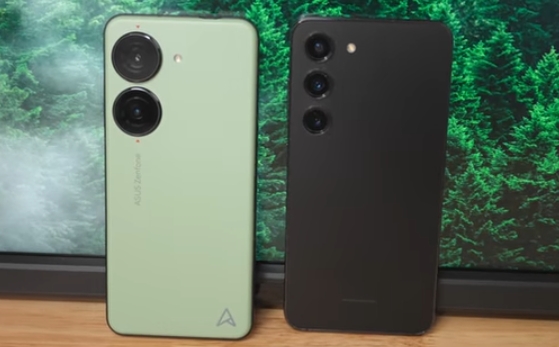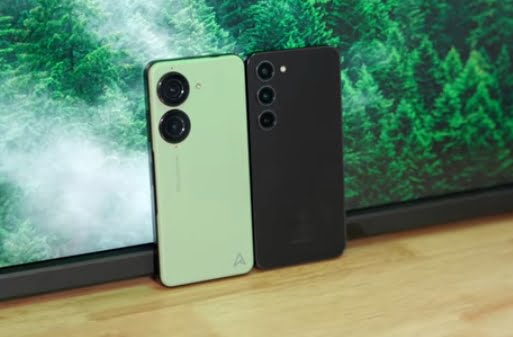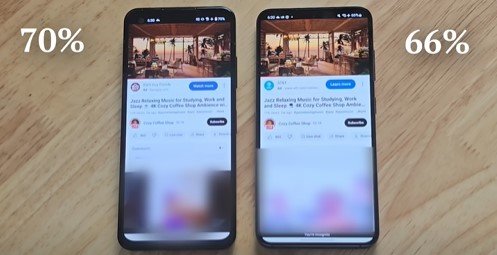The brand new Asus Zenfone 10 with a 5.9-inch screen one of the most compact flagships phone. It boasts the latest 8 Gen 2 SOC and a 50-megapixel camera. For someone seeking a more compact phone this could be the perfect phone. The Zenfone 10 is smaller than the Galaxy S23, which has 6.1-inch screen. So, can the Asus Zenfone beat Samsung Galaxy S23?
Note: This article contains Amazon affiliate links. If you make a purchase through these links, I may earn a commission at no extra cost to you.
Design and Build Quality

Starting with their designs, the Asus Zenfone 10 definitely has some unique design choices, It features two huge cameras, although the lens inside takes up only a small portion of that space. The large size could be justified for the six-axis gimbal stabilization of the main lens, while the ultra-wide lens might be made to match aesthetically. Upon closer inspection, the ultra-wide lens is actually quite small within a big black circle. Additionally, the two camera bumps are not of the same height.
In comparison, the camera bump on the Samsung Galaxy S23 is significantly smaller, and personally, I prefer its sleeker look. The Galaxy S23 also has fewer branding elements on the back, which gives it a cleaner appearance, And the biggest difference lies in the materials used for the backs of the phones.
While the Galaxy S23 has a matte glass back, the Zenfone 10 back is made of plastic. The glass back definitely feels more premium, but the Zenfone 10 back has a unique texture, It can be described as a very fine-grained sandpaper, providing a grippy rough feel. It doesn’t feel like the typical matte plastic found on other phones. I’m undecided on whether I prefer the rough texture.
On the other hand, I’m a fan of the color options available for the Zenfone 10, including white, blue, and a very dark matte black that almost appears grayish when compared to Galaxy S23.

Because of its plastic back, the Zenfone 10 doesn’t provide the same level of scratch resistance as the glass back of the Galaxy S23. The back of the Zenfone 10 is very thin, so when you press on certain spots, it bends a bit. Additionally, when you play audio out loud, the back vibrates quite strongly. I thought it was kind of neat because it made the experience more immersive but after a while, it got pretty annoying. Surprisingly, even though the Zenfone 10 has a plastic back, it weighs about the same as the Galaxy S23.
Screen and Speakers Quality

Moving on to the screens, the Zenfone 10’s bezels aren’t uniform—they’re a bit thicker at the top and especially at the bottom. Once you notice it, you can’t unsee it, and it bothers me a little sometimes. It also has a small hole punch camera at the top left corner. The Zenfone 10 screen can normally refresh at up to 120Hz, and up to 144Hz when gaming. You can technically force non-gaming apps like Chrome to run at 144Hz, but browsing at that rate doesn’t feel much different from the typical 120Hz experience.

On the other hand, the Galaxy S23 has an adaptive 120Hz refresh rate. Aesthetically, it has much more uniform and thinner bezels, which makes it look better overall. It can reach a peak brightness of 1750 nits, matching the peak brightness of the Galaxy S23 Ultra. I don’t have the official brightness specs for the Zenfone 10, but compared to the Galaxy S23 in direct sunlight, it seems slightly dimmer. Still, it’s usable, and indoors, both screens are bright enough. both phones screens offer full HD Plus resolution.
The speakers on the Zenfone 10 are also good, similar to the Galaxy S23. Overall, both phones have good speakers. However the fact that the Zenfone 10 vibrates when playing music is bothersome to me.
Software and Features


Another notable difference between these two phones, the Zenfone 10 and the Galaxy S23, is their software. With the Zenfone 10, you have the choice between stock Android or Asus’s optimized version. Currently, I’m using the optimized version which is pretty good and also comes with lots of extra features that make it very convenient for one-handed use. For example, the power button has additional functions like swiping down for quick settings and double-tapping to open Google Assistant. Even the volume button has a unique feature where double-pressing it when the screen is off opens the camera and takes three photos. These software enhancements really add value to the Zenfone 10 experience.

On the other hand, the Galaxy S23 offers a different software experience with Samsung’s One UI, which comes with a ton of customization options. The Galaxy Store offers themes, wallpapers and functional customizations like changing the home screen layout or customizing the keyboard. Samsung’s OneUI provides a comprehensive set of customization tools that enhance the user experience. Plus, the S23’s one-handed mode is better implemented compared to the Zenfone 10, making it easier to use the phone with a single hand.

Another standout software feature of the Zenfone 10 is the Game Genie lets you designate apps as games and customize their performance mode and refresh rate. You can even force non-gaming apps like Chrome to run at a higher refresh rate. The Game Genie menu gives easy access to performance settings and other gaming-related features potentially making a better choice for gamers. However, some gamers might find the smaller screen size of the Zenfone less desirable compared to a larger display.
Overall the software experiences of the Zenfone 10 and Galaxy S23 offer distinct advantages. The Zenfone 10 provides convenient features for one-handed use and gaming while the Galaxy S23 excels in customization options and a more refined one-handed mode. Ultimately the choice between these two phones depends on individual preferences and priorities.
Read Also: Samsung Galaxy S23 Ultra vs iPhone 14 Pro Max
Battery life

Moving on to their battery life, the Galaxy S23 has a 3900 milliamp-hour battery, which is decently sized. However, the Zenfone 10 surpasses it with a 4300 milliamp-hour battery. To compare their performance, I had both phones play a 4K 60 YouTube video with airplane mode enabled, while keeping Wi-Fi and Bluetooth on. The screen brightness was set to be approximately the same, around 75% on the Galaxy S23 and 80% on the Zenfone 10, Starting at 100%, at the three-hour mark, the Zenfone 10 had 70% battery remaining, while the Galaxy S23 had 66%.
When it comes to charging, the Zenfone 10 supports a maximum of 30 watts for wired charging and 15 watts for wireless charging. In contrast, the Galaxy S23 can go up to 25 watts for wired charging and 15 watts for wireless charging. An additional advantage of the Zenfone 10 is that it still comes with a charging brick, which is becoming rarer in today. It’s convenient to have the 30-watt charging capability right out of the box without needing to purchase any additional accessories. The same cannot be said about the Samsung Galaxy S23.
The battery life and charging capabilities of both phones offer distinctive advantages. The Zenfone 10 larger battery capacity provides extended usage time, while its faster wired charging speed is a notable benefit. Meanwhile, the Galaxy S23 while having a slightly smaller battery still delivers decent performance and its wireless charging options provide convenience.
Performance
| Samsung Galaxy S23 | Asus Zenfone 10 |
|---|---|
| Best loop Score: 3843 | Best loop Score: 3732 |
| Lowest loop Score: 2291 | Lowest loop Score: 2600 |
| Stability: 59.6% | Stability: 69.7% |
As for their performance both phones use the Snapdragon 8 Gen 2 chip. However, the Zenfone 10 experiences less thermal throttling compared to the Samsung Galaxy S23. It can maintain maximum performance for seven minutes straight before experiencing a significant decrease, whereas the Galaxy S23 exhibits a gradual decline. The Snapdragon 8 Gen 2 chip is very fast and delivers excellent performance, particularly suitable for shorter gaming sessions. In everyday use I found both phones to be highly responsive and extremely smooth.
Camera Test

And lastly, let’s take a look at their cameras, which is one area that I had high hopes for the Zenfone 10 because its main lens is 50 megapixels. So, just like last year and also on the Galaxy S23 main lens shares the same resolution and sensor size as other Zenfone 10, but it technically is slightly better in that it gathers more light and can focus quite a bit closer, as you can see above shots. Overall, the level of detail in their photos is pretty similar, but I think the Galaxy S23 has noticeably better processing. The colors overall are just a little bit more pleasant looking, especially flower shot.


It’s a similar story with the ultrawide photos, the level of detail is similar, but again, the Samsung has slightly better color, at least I think so. I also noticed in this Zenfone 10 photo, there’s a doubling artifact on the plane. There are literally two planes, which is kind of weird, and this isn’t even the first time that I’ve seen this artifact. In this beach photo that I took, you can see the seagull also has this doubling artifact, and the picture was taken with the main lens. It almost seems like whenever something is moving, the Zenfone 10 almost doesn’t react fast enough or at least processes it in a wrong way.

The video stabilization is updated on the Zenfone 10, and it’s pretty impressive. But again, the processing just isn’t quite there. I feel like the flower in above shot just looks way too red. I think it looks a lot better in the Samsung video. The Galaxy S23 also has a three times telephoto lens, whereas the Zenfone 10 doesn’t have that, It can use the 50 megapixel main camera to do what they call the hyper Clarity Zoom, but next to a real telephoto lens, it’s just not even close. The Samsung photo just shows much more detail and looks much nicer.
It’s also worth noting that even though both of these phones main lens is 50 megapixels, only the Galaxy S23 allows you to shoot at the full 50 megapixels. There’s no option to toggle that on the Zenfone 10, So all of the Zenfone 10 main lens photos are just the regular 12 megapixels. Most of the time with the Galaxy S23, you’re probably just using the default 12 megapixel mode, but the 50 megapixel mode can definitely be nice for reducing sharpening and getting more detail in a photo. So, it’s nice to have that option, and it’s unfortunate that it’s not even available on the Zenfone 10.
Asus Zenfone 10 and Samsung Galaxy S23 front cameras Just like with the back camera, the photos look pretty similar in terms of the level of detail. However, the Samsung colors are again much better.
Final Thought
So the Asus Zenfone 10 will cost starting $799 and the Galaxy S23 starts same at $799, although sometimes you can get it for cheaper. I assume the Galaxy S23 will be slightly more expensive than the Zenfone 10, but I think the higher price is worth it for the better cameras and having the telephoto lens. The One UI software is very well-refined, highly customizable, and has lots of features. But the Zenfone 10 does have more gaming features and slightly less thermal throttling. So, if you’re primarily interested in more heavy games, then the Zenfone 10 could be a better option.

